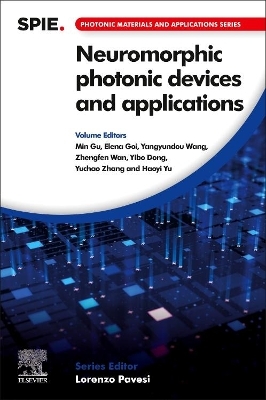
Neuromorphic Photonic Devices and Applications
Elsevier - Health Sciences Division (Verlag)
978-0-323-98829-2 (ISBN)
A brief review of the historical development of the field is provided followed by a discussion of the emerging 2D photonic materials platforms and recent work in implementing neuromorphic models and 3D neuromorphic systems. The application of artificial intelligence such as neuromorphic models to inverse design neuromorphic materials and devices and predict performance challenges is discussed throughout. The book includes a comprehensive overview of the applications of neuromorphic photonic technologies and the challenges, opportunities, and future prospects facing the field.
Neuromorphic Photonic Devices and Applications is suitable for researchers and practitioners in academia and R&D in the multi-disciplinary field of photonics.
Min Gu is Executive Chancellor of the University Council and Distinguished Professor of University of Shanghai for Science and Technology. He was Distinguished Professor and Associate Deputy Vice-Chancellor at RMIT University and a Laureate Fellow of the Australian Research Council. He is an author of four standard reference books and has over 500 publications in nano- and biophotonics. He is an elected Fellow of the Australian Academy of Science and the Australian Academy of Technological Sciences and Engineering as well as Foreign Fellow of the Chinese Academy of Engineering. He was awarded the Einstein Professorship, the W. H. (Beattie) Steel Medal, the Ian Wark Medal, the Boas Medal, the Victoria Prize for Science and Innovation and the 2019 Dennis Gabor Award of SPIE. Elena Goi received her B.S. and M.S. in physics from the University of Trieste. In 2018 she was awarded her Ph.D. from RMIT University, Australia, under the supervision of Prof. Min Gu. She is now an early career researcher at USST, Shanghai, China. Her current research includes the development and implementation of hybrid three-dimensional (3D) nanolithographic techniques that enable the study of novel 3D optical materials and architectures for optical neural networks. Dr Wang received her B.S. in Biomedical Engineering from Changzhi Medical College and M.S. in Communication and Information Engineering from Northwestern Polytechnical University. In 2017 she was received her Ph.D. in Theoretical Physics from Free University, Amsterdam, under the supervision of Prof. Emil Wolf and Prof. Taco D. Visser. She is now an early career researcher at USST, Shanghai, China. Her current research includes the development of nanoscopic imaging techniques and its implementation in neuroscience for the development of nanophotonics chip Dr. Wan received his B.S. degree in Physics from Xinjiang University and M.S. degree in Physics from Zhejiang University in 2008 and 2010, respectively. After graduated from Zhejiang University, he worked about 6 years as engineer in the industry field of semiconductor devices. He pursued his Ph.D. at Griffith University, Australia, since 2016. After submitted the thesis in 2019, he got the research fellow position in Griffith University. In 2020, he received the Doctor’s degree and joined Prof. Min Gu’s research group as postdoctor at University of Shanghai for Science and Technology. Editor # 6: Dr Dong received his B.S. in electronics from the University of Shanghai for Science and Technology. In 2020 he earned Ph.D. degree in electronics from Beijing University of Technology with a research focus on graphene optoelectronic devices and graphene growth. He joined the Centre for Artificial-Intelligence Nanophotonics established by Prof. Min Gu in summer 2020. His current research interest is to develop novel optical diffraction neural network based on two dimensional materials enabled by laser direct writing. Dr Zhang received him B.S. in optical information from Beijing University of Posts and Telecommunications, China. And in 2014 he was awarded the Ph.D. from Institute of Microelectronics, Chinese Academy of Sciences, China. He is now a researcher at USST, Shanghai, China. Him current research is using nano-photonics including metasurface and metamaterials to construct optical neural networks. Dr Haoyi Yu received his M.S. in condensed matter physics from Nankai University, China. In 2019 he earned Ph.D. degree in nanophotonics from Royal Melbourne Institute of Technology University, Australia, with a research focus on neuron-inspired nanophotonics. He joined the Centre for Artificial-Intelligence Nanophotonics established by Prof. Min Gu in March 2021. His current research interest is to develop novel nanophotonics system by laser direct writing.
Section 1: Introduction
1. Neurons, brain and nervous system
2. Neuromorphic computing
3. Advanced neuromorphic models
Section 2: Neuromorphic Photonics
4. Development of the field of Neuromorphic Photonics
5. Photonic devices for neuromorphic systems
6. 2D Neuromorphic photonic components
7. 2D Neuromorphic Photonics
8. 3D Neuromorphic photonics
9. Neuromorphic systems enabled by photonics
10. Neuromorphic models applied to photonics
Section 3: Applications
11. Photonic accelerators for AI
12. Deep optics
13. Neuromorphic processing for optical communications
Section 4: Perspective
14. Perspective
| Erscheinungsdatum | 12.12.2023 |
|---|---|
| Reihe/Serie | Photonic Materials and Applications Series |
| Verlagsort | Philadelphia |
| Sprache | englisch |
| Maße | 152 x 229 mm |
| Gewicht | 450 g |
| Themenwelt | Informatik ► Theorie / Studium ► Künstliche Intelligenz / Robotik |
| Technik ► Elektrotechnik / Energietechnik | |
| Technik ► Fahrzeugbau / Schiffbau | |
| Technik ► Maschinenbau | |
| ISBN-10 | 0-323-98829-6 / 0323988296 |
| ISBN-13 | 978-0-323-98829-2 / 9780323988292 |
| Zustand | Neuware |
| Haben Sie eine Frage zum Produkt? |
aus dem Bereich


